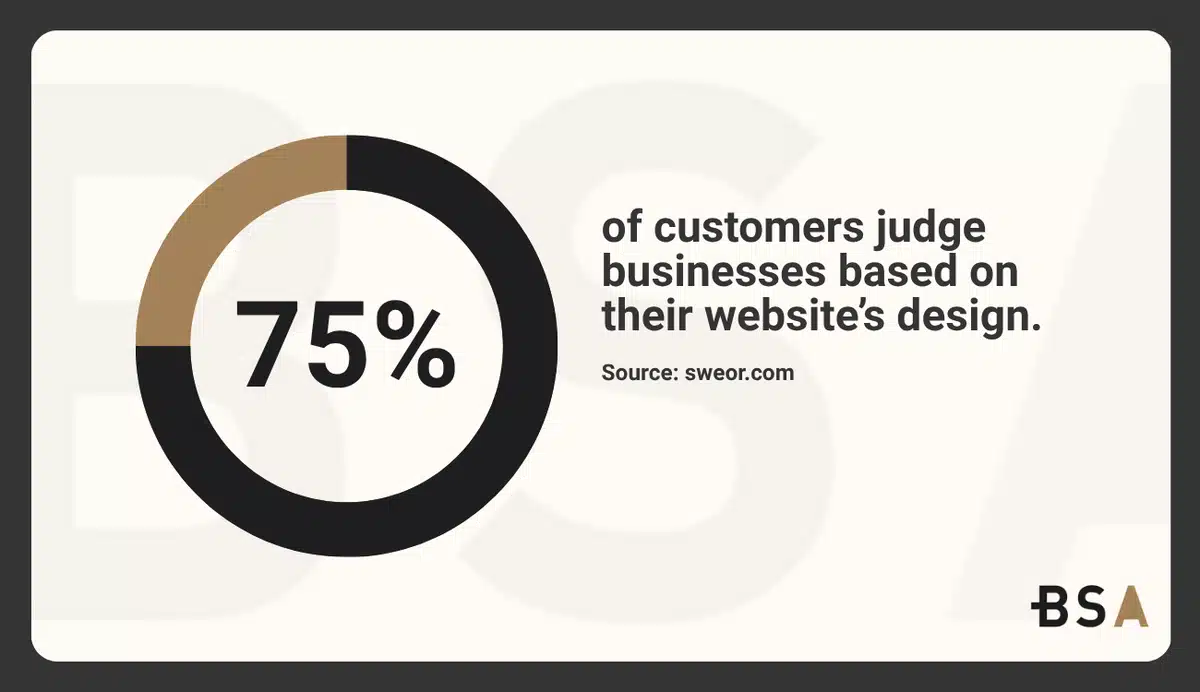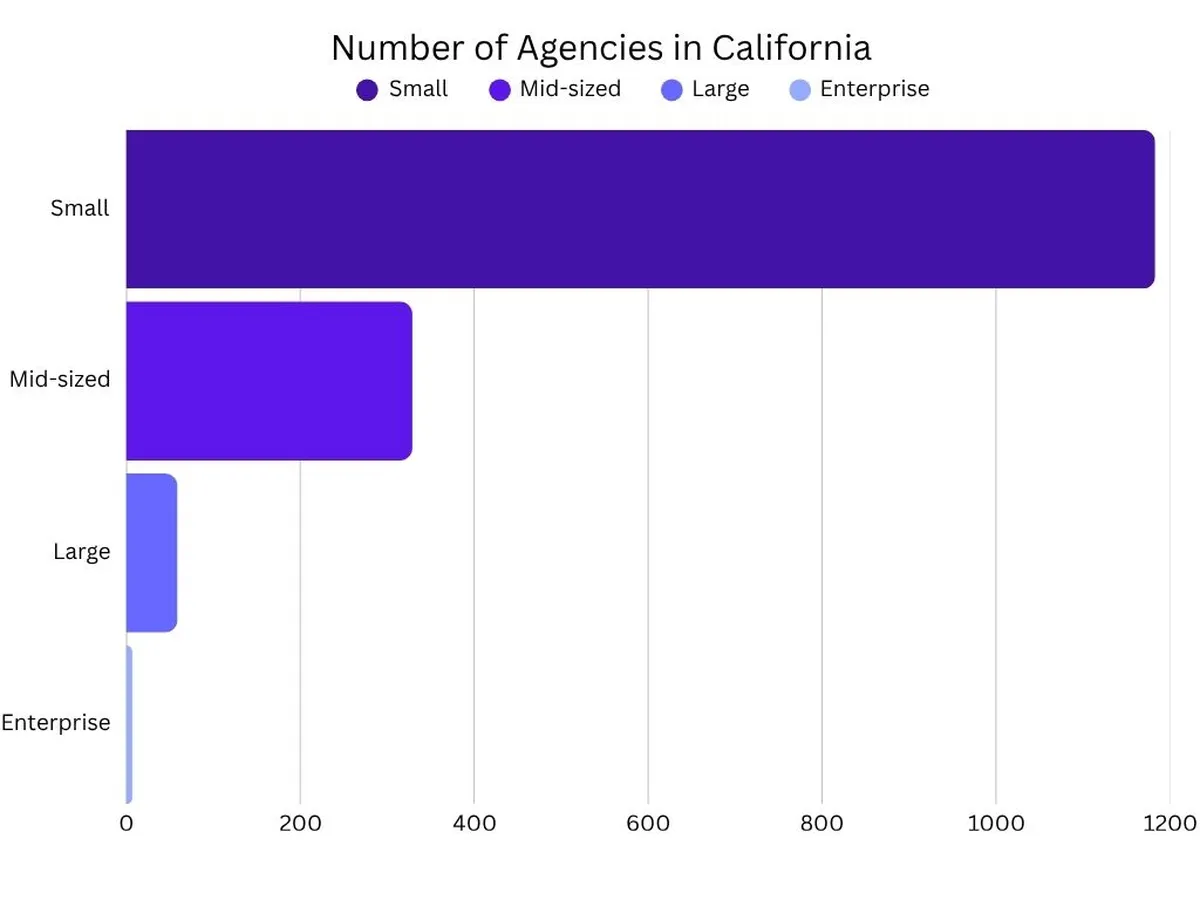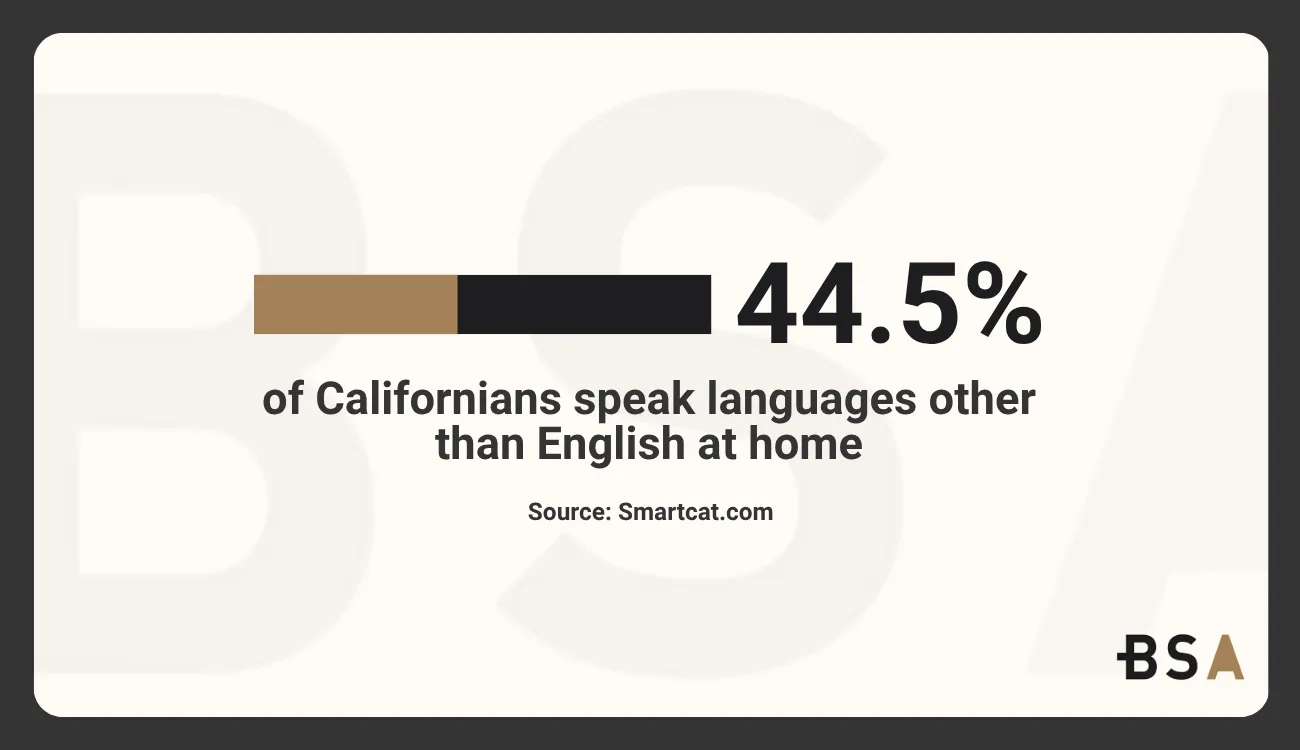California Web Design Industry: Stats, Data & Overview

A well-laid-out and accessible California web design website can boost conversion rates by up to 200%. This powerful statistic shows why good web design plays a crucial role in your business’s success in the Golden State.
Your company’s trustworthiness depends heavily on your online presence.
75% of customers judge businesses based on their website’s design.
And this means that websites with excellent user experience see conversion rates 400% higher than those with poor design. This shows the impact of good design on success.
California stands out in web design due to its cultural diversity and tech-savvy environment. Modern homepages now include accessibility options 95.9% of the time, while visuals shape 55% of a brand’s first impressions.
Creating a great website with essential features requires tech skills and knowledge of how users think. This piece helps you find full stats on California’s website design market. It covers growth patterns and freelance numbers.
This way, you can make smart choices for your digital presence.
In need of a new custom website but don’t know where to start? We can help.

California Web Design Market Size and Trends
The California web design sector holds a major share of the national digital design economy. Revenue figures show steady growth as the market evolves. Technology and business needs drive this change.
Annual revenue trends in the California web design sector
California’s graphic design industry, which covers web design services, brings in about $2.14 billion in annual revenue. This number shows the state’s strength in the digital world.
The sector’s growth stems from careful development. The national web design services industry has grown at a compound annual growth rate (CAGR) of 2.2% in the last five years.
More businesses recognize the importance of having a strong online presence. This awareness is evident in the steady rise.
Key drivers of demand in California’s digital design market
Major economic sectors create the need for web design services in California. The tech industry leads this charge by adding about $620 billion to the U.S. economy.
The tech sector’s total effect grows even larger. Adding nearly $1 trillion to California’s GRP and making up 30% of the state’s economy. This massive economic presence creates an ongoing need for quality digital design services.
California’s entertainment industry adds $405 billion in yearly economic output, while healthcare spending reaches $410.90 billion. Both fields need sophisticated websites to connect with their audiences.
The software industry alone adds $90.50 billion in direct value-added GDP to California’s economy.
California’s advertising industry is worth $14.9 billion and employs over 28,500 people. This growth increases the demand for web design services. Companies want to create consistent brand identities across digital platforms.
The West region benefits from housing tech giants like Google and Apple. These companies need lots of websites to promote their services. This leads to a strong demand for web design services in the area.
This strong economic system helps web design firms succeed despite fierce competition. New companies in California can start with minimal investment.
Just software, developers, and office space. Low startup costs allow many small companies to enter the industry. This lowers market concentration and boosts competition.
Freelance and Agency Landscape in California
California is the heart of web design talent in the United States. The state has fostered a vibrant ecosystem.
In this environment, established agencies and independent professionals can both succeed. Clients can choose from many service providers, but they must understand what makes each option unique.
Number of web design companies in California statistics
The Golden State has more web design talent than anywhere else in the country.
DesignRush, a major industry platform, includes nearly 1,600 California-based web design agencies in its directory of 18,500+ firms nationwide. This represents about 8.6% of all tracked agencies. That’s quite impressive for just one state.
These numbers make more sense when we look at the national picture. The web design services sector in the United States keeps growing.
California’s major cities have different pricing structures for web design.
Los Angeles agencies charge between $1,500 and $50,000 per project. The top firms there charge $111 per hour on average. San Francisco’s best web designers charge around $89 per hour. These rates show how valuable California’s design talent is nationwide.
Freelance web design statistics in California
Independent professionals are vital to California’s web design workforce.
The average freelance web designer in California makes $34.40 per hour recently. The best designers can earn up to $42.24 per hour. This shows how much skilled specialists can make.
Different cities in California pay different rates. Berkeley pays freelance web designers the most at $42.68 per hour. Los Angeles and San Francisco are major freelance hubs. They rank second and ninth among all U.S. cities for freelance work.
Distribution of agencies vs independent professionals
California’s web design providers follow interesting patterns. Small agencies with fewer than 49 employees make up 75% of all design firms. This shows clients value specialized expertise and personal service more than company size.
Mid-sized agencies with 50-249 employees make up about 20% of California’s web design businesses. These companies handle complex projects that need more expertise and resources. They connect small boutiques that have few resources with larger businesses that charge more.
Large agencies with 250+ employees and enterprise-level organizations with 1000+ employees are rare. DesignRush tracks only 59 large agencies and 11 enterprise firms. These companies usually work with major corporations on big digital transformation projects.
The market breakdown by company size is:

Small agencies thrive because it’s easy to enter the web design field. Starting a web design company requires little upfront money. You mainly need software, a few developers, and office space. This helps small companies get started.
So, it boosts competition and lowers market concentration.
Choosing between an agency or a freelancer in California depends on a few things. Think about your project size, budget, and the level of personal attention you need. Agencies offer more services and team resources. Freelancers provide direct communication and might cost less for simple projects.
User Behavior and Design Expectations in California
California’s web design industry keeps changing as users develop new habits and priorities. Businesses must grasp these patterns to create websites that engage California’s diverse audience.
Mobile-first behavior among California users
Mobile devices now rule the digital world in California. The numbers show that mobile devices generate over 61% of global web traffic. This has changed everything about how websites work. Businesses must put mobile design first to reach California’s active audience.
Californians switch between their devices all day. They want their experience to be smooth no matter what screen size they use. Websites need to adapt automatically to different displays. Those that don’t work well on mobile phones risk losing many potential visitors.
Google now ranks websites based on how they work on mobile phones, not desktop computers. This change means a lot to California businesses. Bad mobile performance lowers search rankings and raises costs to find new customers.
Mobile users behave differently. They don’t pay attention as long, want pages to load faster, and like content in smaller chunks. Buttons and interactive parts need to be big enough to tap easily. Nobody likes tapping the wrong thing by mistake.
California tech companies know this well. The state government recently rebuilt its website to work better on phones and added better search features. This shows that both the public and private sectors know mobile optimization is crucial to success.
Explore how we increased Voss Water’s engagement rate by 43% with a completely new web design.
Cultural diversity and multilingual design needs
California ranks among America’s most diverse states. This creates special design needs you won’t find in other markets.
As of now, 44.5% of Californians speak languages other than English at home. This changes what people expect from websites.

Spanish leads the way with over 10 million speakers – that’s 26.67% of California’s population.
But California’s language map goes way beyond English and Spanish.
Overall, the state has at least 20 languages with 50,000+ speakers each. These include Chinese, Tagalog, Vietnamese, Korean, Armenian, and Persian. The state recognizes this diversity by offering voting ballots in 27 different languages.
Research on multilingual users shows 2 interesting facts:
-
52% of people buy only from websites in their first language.
-
90% of bilingual residents pick websites in their native language if they can.
These numbers prove that multilingual websites do more than just include everyone; they help businesses make more sales. Cultural diversity shapes how websites look and work. More websites for California audiences now provide language options and tailored content.
Local design agencies make sure translations are culturally accurate, not just word-for-word. This helps businesses avoid cultural mistakes and connect better with California’s diverse communities.
Visual storytelling preferences in Californian markets
Visuals make a big first impression on California users. Studies show they account for 55% of what people first think about a brand. In California’s competitive market, good visual storytelling helps brands stand out.
California consumers like visual stories about sustainability, community work, and ethical business. These preferences match the state’s eco-friendly culture and social awareness. Good custom website design tells brand stories that strike a chord with these values.
California’s diverse audience needs different visual approaches based on who they are and what they care about. Design agencies tell stories, share pictures, and include interactive features. This helps create emotional connections, not just share information.
Web designers who focus on California know that being real matters most. Local agencies try to create genuine experiences rather than artificial ones. This builds stronger connections between brands and California audiences.
Digital design agencies tell stories that touch California website visitors emotionally. This goes beyond just making things look nice; it creates meaningful interactions that turn visitors into brand supporters.
The California government uses these ideas too. The CA.gov website now offers services based on where you live and better ways to find what you need. This shows that both the government and businesses know visual connections matter.
Legal and Accessibility Compliance in California
Web designers in California have special legal requirements. These rules are different from those in other states. The state has strict accessibility and privacy rules. Businesses must follow these when they create digital properties.
Unruh Civil Rights Act and ADA compliance
The Unruh Civil Rights Act is California’s lifeblood accessibility legislation. This 64-year-old law bans business discrimination based on protected characteristics, including disability. The Unruh Act packs more punch than federal rules – violators must pay statutory damages of at least $4,000 per offense.
This law proves effective for web designers through its connection to the Americans with Disabilities Act (ADA). Any ADA violation has automatically broken the Unruh Act since 1992. This double liability pushes California businesses to make digital accessibility their top priority.
The law covers more than brick-and-mortar stores. California courts have ruled that the Unruh Act applies to websites linked to public-facing businesses. Companies that don’t have a physical presence in California must still follow the Act. This applies if they do significant business with state residents.
The 2020 court case Thurston v. Fairfield Collectibles revealed that out-of-state businesses selling to Californians must follow the Unruh Act. The court saw the Georgia retailer’s website as “equivalent to a physical store in California” because approximately 10% of its sales came from California customers.
Websites must follow WCAG 2.1 Level AA standards. This ensures compliance with the ADA and Unruh Act. This standard helps businesses avoid legal issues.
CCPA and data privacy design requirements
California takes a progressive stance on digital rights. It protects data privacy through the California Consumer Privacy Act (CCPA). This complete law gives California residents data privacy rights and requires organizations to protect personal information.
The CCPA applies to businesses that meet any of these criteria:
-
Annual gross revenue exceeding $26,635,000.
-
Processing data of over 100,000 California consumers.
-
Deriving 50% of annual revenue from selling personal information.
Web designers must include specific elements to meet CCPA rules. Websites need a clear “Do Not Sell or Share My Personal Information” link on their homepage.
They must also add ways for users to submit data requests, which businesses must answer within 45 days.
CCPA demands special attention to privacy policies. These policies need to be updated every year. They must also be in clear alternative formats to ensure accessibility. Organizations must explain their personal information collection, usage, and sharing practices.
The California Privacy Rights Act (CPRA) updated the CCPA on January 1, 2023. It created the California Privacy Protection Agency to enforce the law.
CPRA sets rules for managing sensitive information, such as exact location data, religious beliefs, and biometric data. Consumers can now limit how companies use and share this data.
Accessibility tools and inclusive design practices
California organizations now use specialized tools to meet digital accessibility requirements. The California Department of Technology suggests several free testing resources:
Web Accessibility Evaluation Tool finds WCAG errors through a browser extension.
Lighthouse, another browser extension, checks website performance and accessibility. Siteimprove and AxeDev Tools help organizations check multi-step forms and dynamic content for accessibility issues.
Inclusive design principles shape many California web projects. These principles focus on fitting diverse body sizes and abilities. They ensure people can see information easily and make operation methods accessible. Cal Poly’s “Inclusive Design Champions” program highlights the state’s commitment to accessible design. It honors programs and services that reflect the philosophy of inclusive design.
State agencies must follow WCAG 2.2 Level AA success criteria and check their websites’ accessibility every two years. This requirement has improved accessibility standards in California’s web design industry. It sets higher baselines for all digital properties.
Accessible websites boost user trust, grow customer bases, and make sites better for everyone. California is the leader in digital inclusion standards. Web designers who prioritize accessibility can succeed in this competitive market.
Learn how we increased Alloy’s engagement rate by 51% with a new web design here.
Technology Trends Shaping California Web Design
The digital world of California’s web design sector continues to change as new tools and methods emerge. New design frameworks and smart decision-making keep the state at the forefront of digital advances.
Web design trends California businesses are adopting
California businesses focus heavily on accessible design principles. State guidelines say that “all public websites and digital services must focus on user needs. Data-driven analysis should guide management and development choices.”
This strategy uses both qualitative and quantitative data to understand user goals and behaviors.
Visual storytelling plays a vital role since California designers know visuals make up 55% of first impressions. State brands pick designs that highlight eco-friendly practices, community support, and ethics.
These values are part of California’s culture. This is especially important for startup owners in California who want to grow organically.
Web designers in the Golden State build cultural sensitivity into their work because of the state’s rich diversity.
Many sites offer customized services based on user location with expanded navigation tools that mirror the CA.gov website’s recent development.
Use of A/B testing and analytics in design decisions
Informed decision-making serves as the lifeblood of web design strategy in California. Businesses can increase revenue by 760% through analyzing, segmenting, and creating customized customer experiences. Analytics have become essential.
California web designers regularly use various analytics tools.
-
Google Analytics and Search Console track user behavior metrics like bounce rates, page views, and session durations.
-
Heatmaps such as Hotjar show visual representations of where users click, scroll, or leave pages.
-
A/B testing verifies design decisions by comparing two versions to find out which performs better.
These methods help designers optimize everything from call-to-action placement to content structure. A/B testing shows different users two versions of the same design while keeping all but one element similar.
Results clearly show which version performs better.
Adoption of responsive and adaptive design frameworks
California designers prioritize frameworks that work naturally across all devices. Two main approaches lead the way: responsive and adaptive design.
Responsive design works like water poured into different glasses. Content adapts smoothly to screen dimensions without changing its basic nature. One codebase automatically reformats based on device specifications.
Adaptive design works more like cookie cutters, creating distinct shapes. Designers build multiple layouts for specific screen sizes (typically 320px, 480px, 760px, 960px, 1200px, and 1600px). The system picks the right layout based on the user’s device.
California web standards say that websites must be responsive and adaptive. This means that users with mobile devices, no matter their size, should have equal access to government information and services just like desktop users. This requirement has made cross-device compatibility standard throughout the state’s digital ecosystem.
Get a Custom Website That Helps Your Californian Business Thrive
California leads the vanguard of the web design industry and shapes digital trends that influence the entire nation. The state has more than 25,300 specialized firms. This creates a space where cutting-edge ideas thrive in healthy competition.
This market is growing fast. Businesses see that good web design builds customer trust and boosts conversion rates.
Having a good website is non-negotiable now and potential customers will look for another brand if your website doesn’t deliver.
So what now? That’s where we come in. Here at Blacksmith, we’re experts in web design and creating custom websites that stand out and increase your conversion rate.
As a professional Los Angeles web design company, we have a group of seasoned web designers ready to create the perfect website for your local business in California. By using modern web design trends and practical SEO strategies, we’ll provide you with a custom website that gives you the organic traffic your brand deserves.
Not sure if investing in a custom website for your California business is a good idea?
Don’t worry, click here to set up a call with us and we’ll provide you with a complete audit of your current website and brand. This way we can show you what areas need work and what we can do to help your business grow.
